Part
6 : The Seaside Holiday Photograph (continued)
Photographers
on the Pier
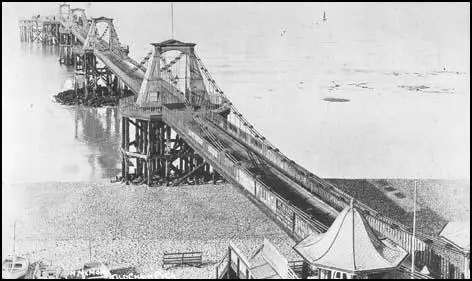
The
Chain Pier, Brighton in the 1890s.
Photographers on the Pier
The Chain
Pier
As
early as 1824, the Chairman of the Brighthelmstone Suspension
Pier Company had announced that thousands of visitors had come
to Brighton to see the Chain Pier, "a structure that has
been the subject of conversation throughout the Kingdom."
A number of amusements were based on the Chain Pier to entertain
and serve the visitors who promenaded along the pier's 350 yard
long platform. A silhouette artist operated in a kiosk under the
third tower and "with scissors only" made full length
portraits of visitors. The silhouette artist Edward Haines
worked on the Chain Pier between 1830 and 1860 and charged !s
6d for a head and shoulders portrait and 2s 6d for a full length
silhouette. In October 1853, the proprietor of the Royal Chain
Pier Photographic Rooms was offering "portraits superior
to engravings by the new process on glass, complete in case or
frame" for the price of 5 shillings.
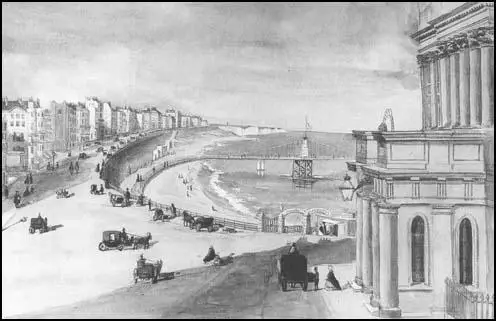
A painting dated 1861 showing
the old entrance and the esplanade leading to the Chain Pier.The
little group of houses against the sea wall, sitting directly
opposite the Chain Pier, housed a number of photographic studios
over the years.
The
Chain Pier and its esplanade became crowded with visitors
and so was an ideal location for a portrait photographer. In 1858,
Charles Combes, who had previously ran a daguerreotype
portrait studio with his brother John Combes at 62, St
James Street, took photographic portraits on the esplanade of
the Royal Chain Pier. G.A.Lloyd was running a photographic
booth at 3a Chain Pier in the late 1860s and photographic portraits
were taken on the same site by a Mr.Weller from 1870 to
1875. In 1881, the photographer at 3 Chain Pier was a Mr.G.H.Hemmings.
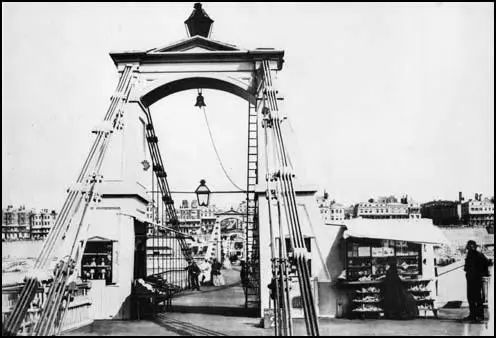
The Chain Pier, Brighton,
seen from the pier head.(c1870).The towers supporting the chains
housed small shops, selling sweets and souvenirs. The towers also
provided little studios for silhouette artists and portrait photographers.
The
Chain Pier and Madeira Road
The
Chain Pier had its entrance at a toll house near the bottom of
the Old Steine and was reached by means of an esplanade which
ran along the top of the beach. The Chain Pier Toll House and
Esplanade were demolished to provide the site of Brighton's Aquarium,
which opened in August 1872. Two new toll houses were erected
at the foot of the Chain Pier. A new esplanade was built on a
recently constructed sea wall and was given the name Madeira
Road.
In
January 1881, the photographer Alfred Sharp was running
the Chain Pier Studio at 2 Madeira Road. Mr Sharp passed on the
Chain Pier studio to a Mr Goddard in 1883. George Owen Goddard
was a cycle maker and operated a bicycle depot next door at No
3 Madeira Road. The firm of Thompson & Gordon also
ran a bicycle depot on Madeira Road and in trade directories for
1886 and 1887, they too are listed as photographers at 2 Madeira
Road.
When
the Brighton Directory of 1884 was compiled, the studio at 2 Madeira
Road was in the hands of Benjamin Combs [Combs was the
younger brother of the early photographers Charles and John
Combes, but Benjamin insisted on spelling his surname differently.]
The
Madeira Road studio carried the name of Combs until 1900, but
for a couple of years around 1890s, a competitor was working as
a photographer from the same address. Page's 1890 Directory lists
B. Combs, photographer, at 2 Madeira Road, but under Photographic
Artists in the Trade Directory, W.H.Gardner is also listed
as a photographer at 2 Madeira Road. Both photographers are listed
at 2 Madeira Road in the 1891 Directory.
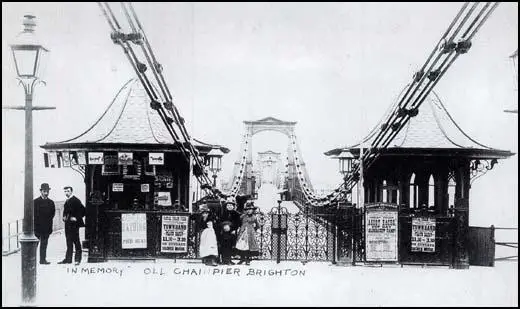
The Entrance to the Chain
Pier, Brighton (c1895).Alfred Sharp's photo booth can be seen
housed in the toll house on the left.
Alfred
Sharp, the original proprietor of the Madeira Road studio,
worked as a beach photographer for about 5 years, but from around
1889 he based himself at the East Toll House at the entrance of
the Chain Pier. Alfred Sharp was the Chain Pier's resident
photographer almost to the end of its existence. In 1896, the
Chain Pier's structure was declared unsafe. On the evening of
4th December 1896, the Chain Pier was completely destroyed
in a violent storm.
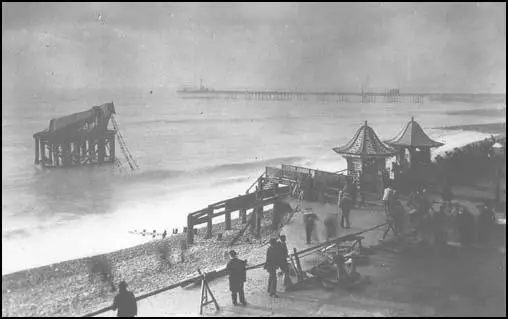
The Chain Pier was destroyed
by a fierce storm on the evening of 4th December 1896.This photograph,
credited to Thomas Donovan, shows all that was left of the Chain
Pier after the gale force winds had done their damage.
Around
1900, to commemorate the lost pier, William Leal opened
the Chain Pier Restaurant at 2 Madeira Road, and for a few years
he continued to take photographic portraits in the Madeira Road
studio.
By
1905, the studio at No 2 Madeira Road was in the hands of Walter
M Carrington who carried on at this address until the First
World War.
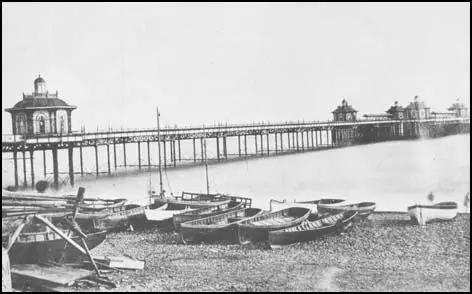
The
West Pier (c1870).
The
West Pier
The
West Pier was constructed opposite Regency Square on the western
seafront, between 1863 and 1866.
The
West Pier was opened to the public on 6th October 1866, but no
photographer is listed with a West Pier address until four years
later. The 1870 Post Office Directory fo Sussex records William
Hall as a photographic artist at 21, North Street and 8, West
Pier. Hall's West Pier studio was taken over by Henry Parnell
around 1873, but his tenure was brief. Robert J. Parnell,
probably a relative of Henry Parnell, also took photographs at
a West Pier address around 1873.
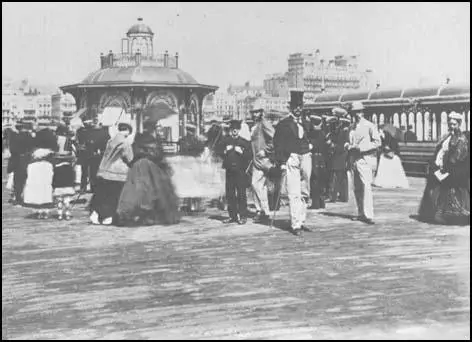
Visitors
to the West Pier listen to a band on the open deck of the pier-head.This
photograph was taken around 1870, when William Hall established
a photographic gallery on the West Pier.
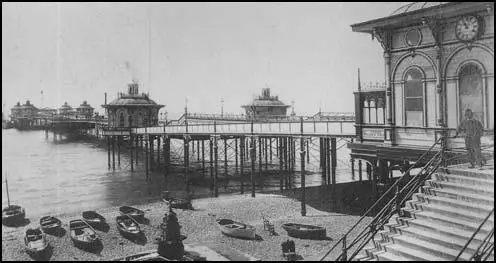
The
West Pier in the early 1880s. The steps on the right led down
to the beach and the Lower Esplanade, where William Dawson operated
a photographic studio for over thirty years.
William
Dawson plied his trade at a spot close to the West PIer entrance
from 1878. Giving his studio address as The Beach until
the early 1880s, Dawson worked as a photographer on the seafront
beyond 1910. He occupied one of the arches under the Kings Road,
very near the West Pier, but he also owned a more orthodox photographic
studio at 128 Richmond Road.
In
the 1891 Census, William Dawson gives his occupation as "Mineral
Water maker, tobacconist and photographer." In the 1890s,
Dawson ran a refreshment bar and photographic rooms at 68 Kings
Road Arches. By 1908, William Dawson was working as a photographer
at 65 Kings Road Arches and also ran a kiosk on the West Pier.
William
H Schwartz, a French born, German photographer, is first mentioned
as a photographer on the West PIer in a directory of 1895. Schwartz
continued taking photographs on the West PIer until 1913, on the
eve of the First World War, a time when his nationality may have
proved to be unpopular.
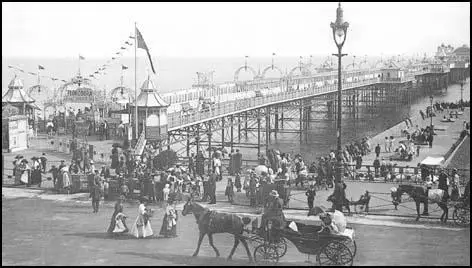
The
Palace Pier, Brighton around 1910.
The
Palace Pier
The
Palace Pier was designed to take the place of the old Chain Pier
on Brighton's eastern seafront. Situated opposite the Old Steine,
the Palace Pier opened to the public on 20th May 1899. By this
date, holidaymakers requiring photographic mementos of their day
at the seaside were well catered for by the numerous beach
photographers, the studios on Madeira Road and the
half dozen photo studios located in the Kings Road Arches on
the seafront . John James Avery, a London photographer,
established a studio with the address The Pier, Madeira Road around
1909, but by the following year he had abandoned his pier studio
and established J.J.Avery's tea rooms at 181 Kings Road Arches.
In the early 1900s, the American Art Rapid Photography Company
ran a photo booth on Brighton's Palace Pier , where holidaymakers
could turn their photographic portrait into a picture postcard.
( See fig. 5 in Section G : Picture Postcards ).
CLICK HERE TO CONTINUE
The Beach Photographer